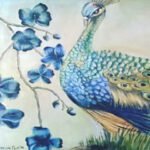The Creative Thinking Process
“Creativity is inventing, experimenting, growing, taking risks, breaking rules, making mistakes and having fun”.
Mary Lou Cook
Creativity is a cognitive process which with starts with sowing the seed born out of inspiration and the subsequent germination and transformation of that seed into a plant. This is makes up the creative process.
All of us have creative potential. Almost every day, we make decisions and act on them by using our creativity. A lot of our daily situations call for a creative solution.
The creation of an artwork is termed the creative process, and contrary to popular belief, it does follow a sequence of steps. In other words, any creative activity, believed to be purely spontaneous, does have a structure and it does follow a pattern. The time taken to complete a project is variable – for example – there is no fixed gestation period for creating a painting or writing a book.
What is the Creative Process in Art?
In simplistic terms, the creative process is the way thoughts or creative ideas come about and unfold. Creativity is a combination of influence, inspiration, and the process of following through with that influence and inspiration. It always begins when, inspired by an idea, the urge to create grabs you and ultimately leads you to create your masterpiece – the finished product. We can break down the creative process into five stages which are as follows –
1.The Preparation Stage
This stage starts with an idea or thought. This idea or thought may or may not happen spontaneously – in most cases, this idea is the outcome of, “consumption”. “Consumption” has been explained by the creative expert James Taylor who says,
“If you’re a musician you are absorbing a lot of the music that is inspiring you to create this new piece. If you’re a writer, you are reading other writers in this area. If you are an artist you are looking at other artist’s work in the area that you are looking at creating something in”.
If you want to optimise your creativity, start by absorbing and consuming as much as you can. Expose yourself to new experiences – travel, read, visit art galleries, interact with people from different cultures…
The preparation stage involves collecting as much information or inspiration as you can, throwing yourself into the planning process and preparing an environment where ideas can grow and be executed.
2.The Incubation Stage
incubation is related to intuition and insight – the incubation stage is about taking time and going within. This is the stage when, all the information that you have collected in the Preparation stage, seeps into every cell of your body and your subconscious mind. This is an extremely important stage of the creative process – sometimes, an idea can incubate for days, weeks, or months. In this stage of the creative process, it is your subconscious that is doing all the work. The conscious mind processes those ideas during the Illumination stage.
3.The Illumination Stage
This is a time of fruition. A time when ideas come to a head- the “Aha!” part of the creative process – that epiphanic moment when all concepts align with each other and finally make sense. The light bulb comes on as now you can actually visualise the end product. All of that material that you have gathered comes together.
The “Aha” moment can happen quite suddenly, out of the blue, like a bolt of lightning! My “Aha” moment once struck me, just as I was drifting off to sleep. I was so charged up and adrenalised by the sequence of thoughts, that I was up for the rest of the night. At this stage the ideas from the subconscious flow into the conscious mind.
The illumination stage is the shortest in the creative process.
3.The Evaluation Stage: This is the point where you consider the viability of your idea aesthetically and commercially. This is also a stage of market research. At the evaluation stage, you look back at your initial ideas and concepts to see if the outcome of your efforts would be in sync with your initial vision. During this period, you might reassess and make edits to work in progress and ask yourself the following questions
- Is it really worth the effort?
- Is it unique enough to create an impact?
- Should I run this idea by a fellow creative?
The Implementation Stage – This is the stage where you dive into the tough stuff – hard work and the implementation of your project. The product of your creativity could be a painting, a musical composition, a book, an architectural project —the product of your efforts, which started as an idea, now comes to life and you bring the object of your creativity out into the world!



Shop these exquisite original paintings now at
https://www.etsy.com/shop/RengeBySabrina
Closing Thoughts
To all my fellow creatives out there, don’t despair if your projects take longer than you had imagined. Instead, surrender to the creative process and enjoy the journey. Feed your senses on a rich diet of inspiration – find what ignites that passion!





